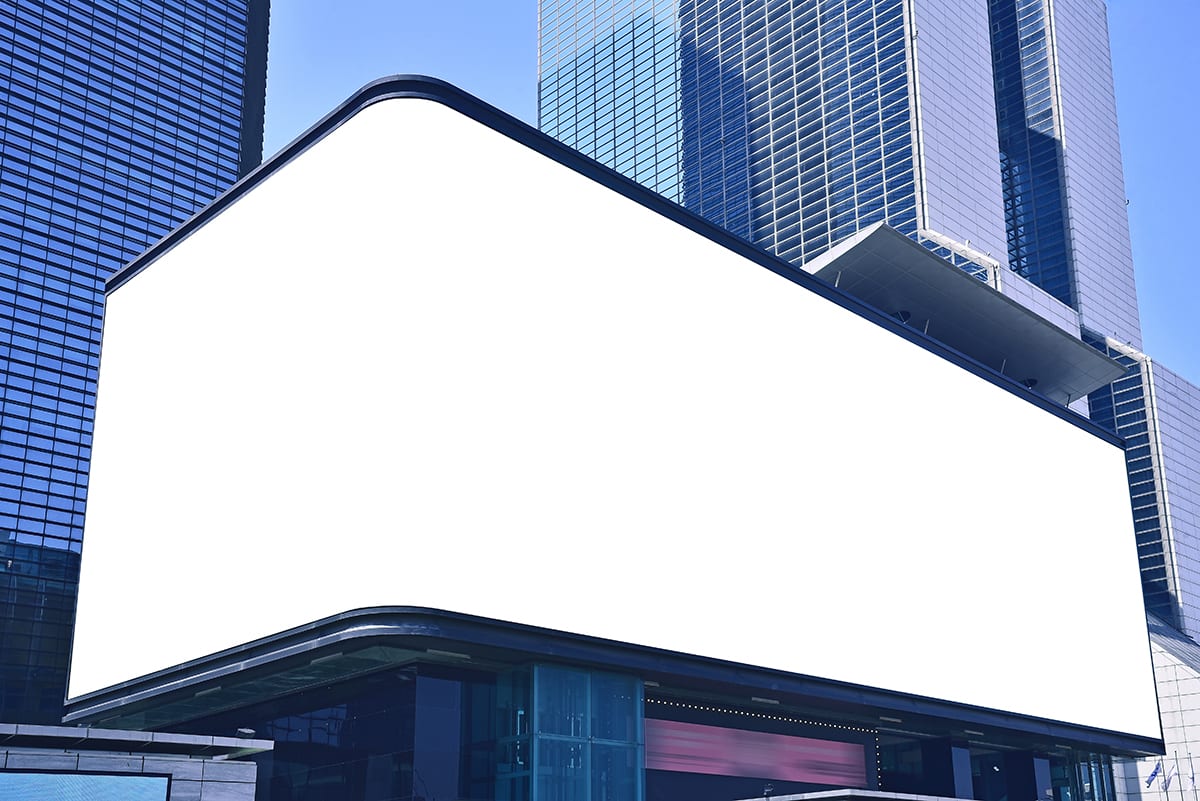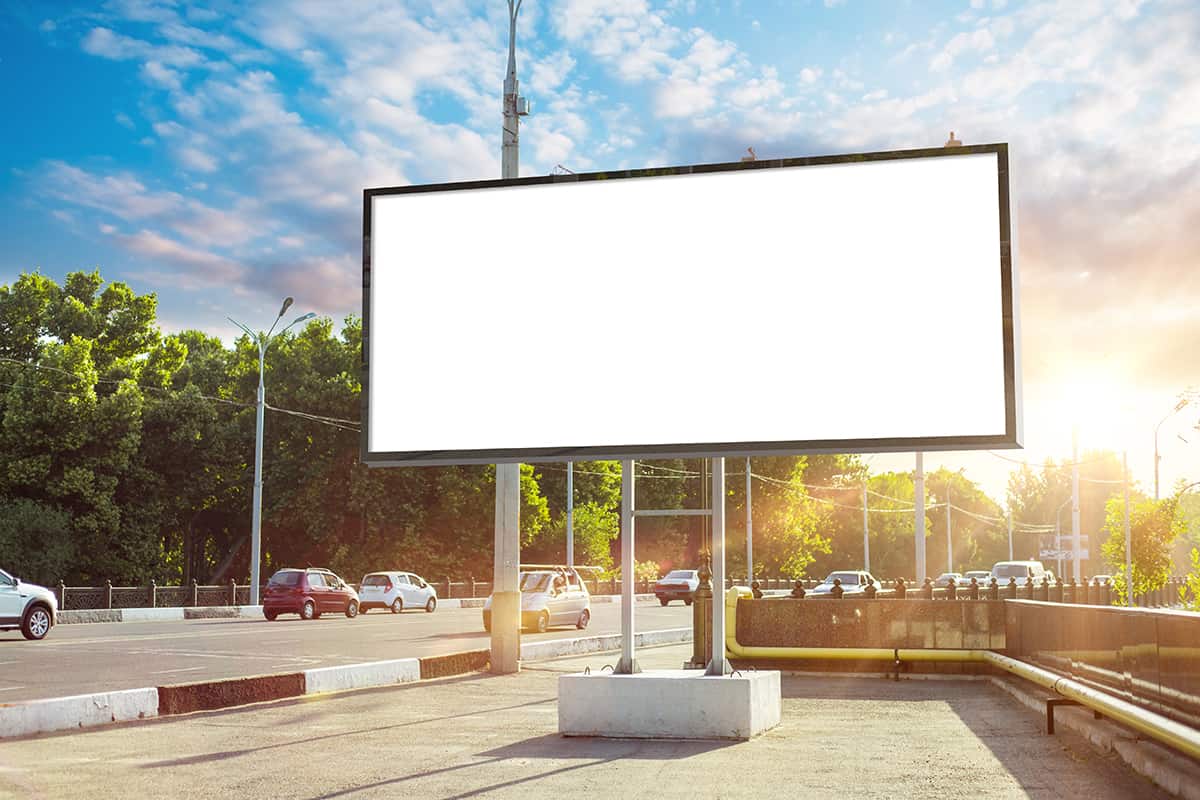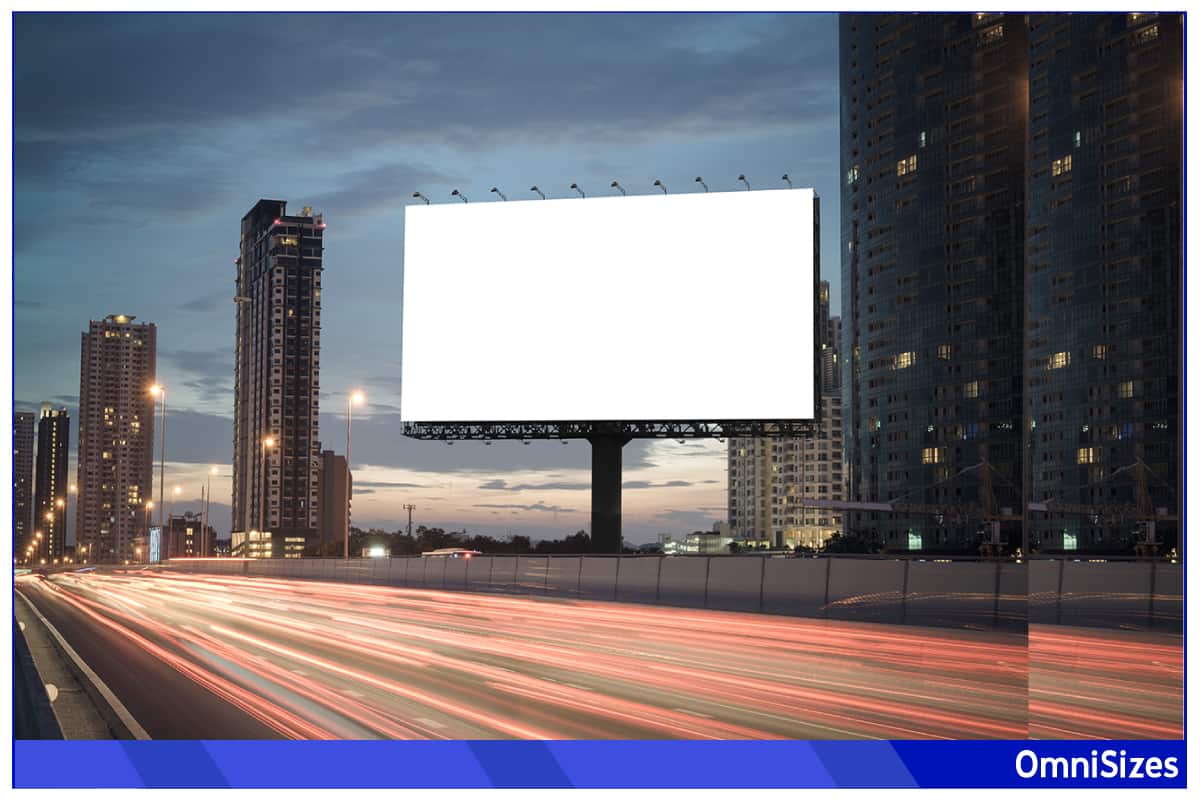If you’re trying to create a buzz for your business, you need to think big when it comes to marketing. And what can be bigger than billboards, which are designed to capture the attention of motorists in slow- and fast-moving traffic? The only question is, what are the different billboard sizes?
Billboards come in a variety of types and sizes, with the common being:
| Billboard type | Height Range | Width Range |
| Junior Poster | 6 feet | 12 feet |
| Poster | 10-1/2 to 12-1/4 feet | 22-3/4 to 24-1/2 feet |
| Bulletin | 10-1/2 to 14 feet | 36 to 48 feet |
| Spectacular | 16 to 20 feet | 60 feet |
This guide will take you through the exciting world of visual marketing by explaining billboard sizes in more detail. It will also cover digital billboard sizes, and potential rental costs.
Why Does Billboard Size Matter?

Ever wondered why billboard size is a big deal in advertising? Well, it’s all about catching eyes and making an impression.
1. Visibility and Impact
Bigger billboards mean more visibility. This is especially crucial along highways or in busy city areas where you want your message to stand out amidst a sea of distractions.
2. Message Clarity
Larger billboards offer more space for clear and bold messaging. This means you can use larger fonts and more detailed images, which are easier for passersby to understand and remember.
3. Audience Reach
A small billboard might go unnoticed in a bustling area, while a large one can catch the eyes of hundreds, maybe thousands, of people every day. The bigger your billboard, the more people you’re likely to reach.
4. Flexibility in Design
With more space, designers can get creative with layouts, imagery, and even add interactive elements like LED displays. This flexibility allows for more engaging and innovative advertisements that can tell a story or create a mood.
Standard Billboard Sizes
Like many things in life, size matters, and this is especially true with billboards. Billboards are those giant poster-like ads that you see on the side of the road in the city and highways. Believe it or not, they’re not all the same size.
1. Junior Poster
Starting small but mighty, the junior poster billboard typically measures 6 feet high and 12 feet wide. This type is perfect for local advertising and are commonly spotted in urban neighborhoods or alongside smaller roads. If you’re trying to generate a buzz in your community with messages that don’t require frequent changing, this is most likely the most cost-effective billboard size.
2. Poster
The poster billboard is a step up in size, usually ranging between 10-1/2 to 12-1/4 feet in height and 22-3/4 to 24-1/2 feet in width. This size hits the sweet spot for visibility without being overwhelming. It’s a popular choice for advertisers looking to make a statement in high-traffic areas like shopping centers or busy streets. They’re large enough to be noticed from a distance, yet small enough to fit in more compact spaces.
3. Bulletin
Then we have the bulletin, the big player in billboard advertising. These massive structures are typically between 10-1/2 to 14 feet high and a whopping 36 to 48 feet wide. Billboards of this size are hard to miss and are usually placed along highways or on major city roads. They’re ideal for large-scale campaigns, national advertising, or for brands looking to make a bold statement. Their sheer size gives companies a ton of playroom to come up with eye-catching designs that are easy to spot from afar.
4. Spectacular
Lastly, we have the spectacular, the giants of the billboard world. These billboards stretch an impressive 16 to 20 feet in height and are about 60 feet wide. They’re typically found in high-profile locations like Times Square or the Las Vegas Strip, where they can become landmarks. Spectaculars often incorporate advanced technology like LED or digital components, which is easy for motorists and pedestrians to notice.
Digital Billboards and Their Dimensions
Billboards have come a long way from being pretty objects on the side of the road. In this modern era, you can rely on digital billboards to convey your message in a unique way.
1. Traditional Digital Billboards
These are the digital versions of your standard billboards. They come in various sizes, often mirroring the dimensions of traditional billboards like junior posters, posters, and bulletins. What sets them apart is their ability to display moving images, change advertisements quickly, and offer more interactive and engaging content. The flexibility in content means these billboards can cater to multiple advertisers.
2. Digital Spectaculars
Think of these as the Hollywood stars of digital billboards. Located in high-traffic areas or downtown districts, digital spectaculars are massive, bright, and impossible to ignore. They’re often custom-sized, sometimes taking one or multiple sides of an entire building. The content can add to a city block’s entertainment and allure.
3. Mobile Digital Billboards
These are billboards on the go, usually measuring around 6 feet high and 12 feet wide, attached to the flatbed of a truck. The beauty of these billboards lies in their mobility. They can go wherever the audience is, from busy city streets to special events. Their sizes can vary, but most stick to the poster size for ease of navigation and cost-effectiveness.
How Much to Rent a Billboard?

Thinking about renting a billboard for your business? The cost can vary widely, and there’s more to it than just billboard size.
Factors Affecting Billboard Rental Costs
Location: Billboards in high-traffic areas or major cities cost more. It’s all about how many people will see your ad.
- Size: Naturally, larger billboards like Bulletins will cost more than smaller ones like Junior Posters.
- Duration: How long you want your ad up affects the price. Longer campaigns usually get a bit of a discount.
- Design and Production: Designing and printing your ad isn’t usually included in the rental cost. More complex designs or digital displays might up the price.
- Digital vs. Traditional: Digital billboards can be more expensive due to their technology and versatility.
Average Costs by Billboard Type
Here’s a general pricing guide to give you an idea:
- Junior Posters: These can range from around $300 to $750 per month.
- Posters: In medium-traffic areas, these can cost between $740 and $2,000 per month.
- Bulletins and Spectaculars: These big guys can set you back anywhere from $750 to over $30,000 per month. Remember, prime locations cost a much prettier penny than rural spots.
- Digital Billboards: Prices vary widely, but expect to pay a premium for these versatile boards. They can start at around $150 per hour, with longer deals costing you much less per hour.
